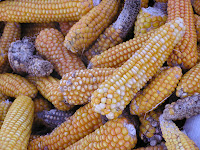 |
| One of the more impressive stalks of corn I've come across; they are usually between 10-12 feet tall, but this one seems to be approaching 15' (I'm 5'8"). I have seen a few fields in marginal land that were only about 7-8 feet tall, but in general, I'm definitely in the land of the tall corn. No wonder so many towns call themselves "[Name of Saint] Milpas Altas." |
At the end of November and beginning of December, the corn is judged to be dry enough for harvest. On a daily basis I see lines of men and boys on the paths heading out to the fields with
costales (feedsacks) slung over their shoulder. Earlier this week, I tagged along with the group heading to harvest my family’s land. Usually this is a two day event for my family, as they have about 5
cuerdas* of land split across six locations, but this year we completed it in one day because the harvest was pretty poor, perhaps due to the extremely wet rainy season.
On the way out to the field, my host “dad” asked me where my tool was. (Sidenote: he’s only 32, so feels more like a brother age-wise, but since the kids claim me as their sister, I’m not sure how to refer to him). Well, in the first instance of Guatemalans being more prompt than I am, they had headed out without waiting on me, so I had rushed after them without getting the tool memo. Luckily, a sympathetic guy in the group lent me his**, showed me a quick slit and slash motion once and I was off and running. Well, fighting my way through the cornstalk jungle.
I think most of the group were just using a nail tied to some string (to loop around their wrist), but I had a lovely gem, carved out of some kind of bone. I asked what kind of bone they use and the answer was “any kind, it doesn’t matter.” This is a classic response in which I ask for specifics and they give me the general answer – for all that my Spanish gets me by, there’s still a language or cultural barrier there that leads to misunderstandings.
 |
| These three were around 10 years old, I think they were earning a little cash on their "summer break." |
We all spread out choosing one line of corn, working from one end of the field to the other. I quickly (although perhaps less efficiently than the others) picked up the rhythm of bending the stalks in half to bring the ears within reach, slit open the husk top, peel back the husks, and wrangle off the ear of corn. Sometimes the corn was pearly and dry, sometimes the ear was half putrid and moldy. We took it all (apparently the rotten stuff goes to animals).
After clearing out one area we dumped our sacks and sorted the corn by quality, bagged it again, and took it to the terrace (roof) of the house to be laid out to finish drying in the sun, there sorted by color as well. Then we moved on to the next area in a different part of town. Since each generation inherits land from their parents, each successive generation has less land, divided into smaller pieces scattered further from one another. It’s not so bad in my family; the grandfather was one of five children, there are three in the parents’ generation, and two children right now (no plans for additional). Many other families have 6-10 children, so I can’t imagine how their land gets parsed out.
*A cuerda is 25 x 25 varas, a vara is officially about 84 cm (but often measured by an arm length). So, theoretically my family grows enough corn to eat each year and extra to sell on a little more than half an acre. On the other hand, it felt like more land than that when I walked it, so I don't have huge confidence in those calculations.
**Was this just a kind gesture to the newbie? Were there gender dynamics at play, either chivalry or sexism? What about class issues; the white girl can't work with her hands? Welcome to the brain of a PCV with a Liberal Arts background and not enough actual work to do just yet. Over-analyze much? Guilty as Charged. Really though, I was thankful he offered it, but uncomfortable taking it since it means he did it bare handed, which gets pretty tiring.







No comments:
Post a Comment